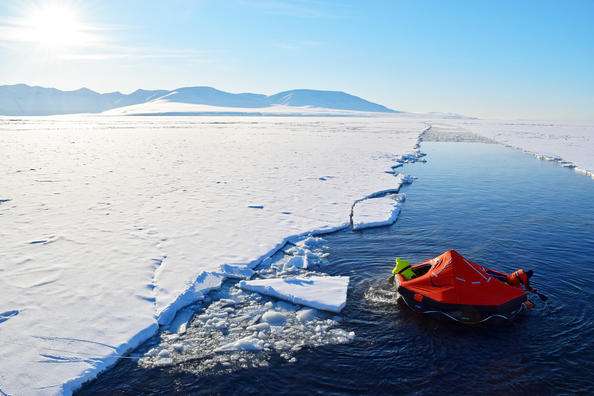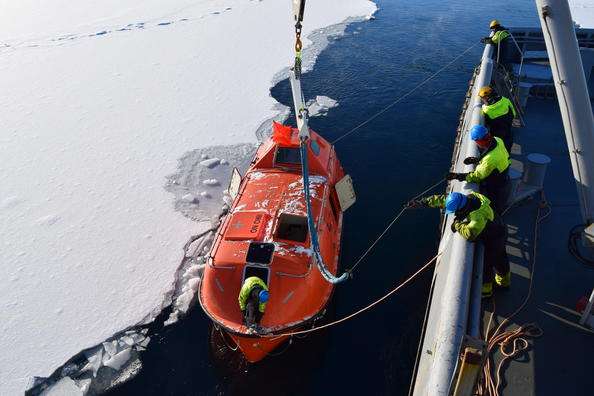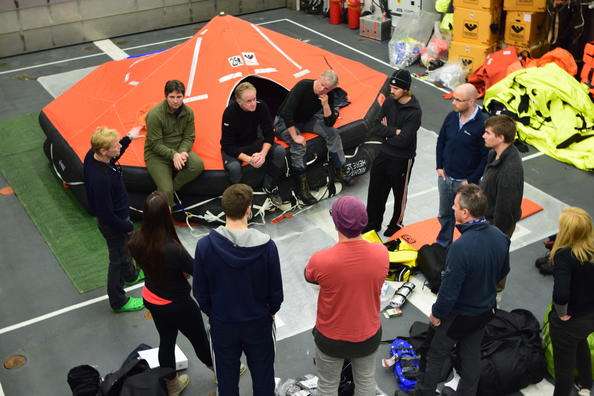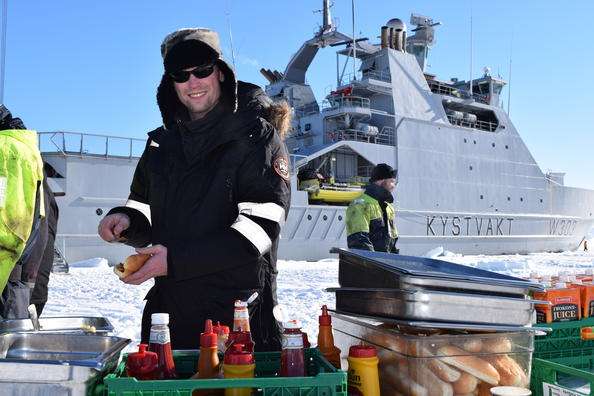Evacuation in the Arctic put to the test

How long could you survive if you became shipwrecked during a cruise in the Arctic ice? In order to find some of the answers to this the Norwegian Coast Guard vessel KV Svalbard served as the home and workplace to a week long research mission, headed by the University of Stavanger, to the remote archipelago of Spitsbergen - or Svalbard - which is its Norwegian name.
"The increase in cruise traffic in the polar regions in recent years is the backdrop to the mission, and a major shipwreck in the waters around Svalbard is a realistic scenario" says professor Ove Tobias Gudmestad from the Department of Mechanical and Structural Engineering and Materials Science at the University of Stavanger, which is responsible for the scientific part of the voyage.
Gudmestad is head of the exercise, which purpose is to evaluate parts of the IMO (International Maritime Organisation) guidelines on operations in polar regions. According to these, on-board emergency equipment should be sufficient to help passengers and crew survive for at least five days while wating for international rescue capacities.
Being realistic
In order to test the equipment that is currently in use, volunteers are left in a lifeboat and a life raft in the ice. Medical personnel supervise the study subjects, who are water-jetted back to the mother ship at their own request this or when instructed by the medical co-ordinator to break up.
Keep in mind that the exercise takes place at 79° 30′ N in the freezing waters of the Woodfjord in North-Western part of Svalbard - out of satellite range and with armed guards constantly on the outlook for polar bears.
The research project is taking place under the auspices of the University of Stavanger in co-operation with NTNU (the Norwegian University of Science and Technology), the University of Tromsø, the Arctic University of Norway, St. Olav Hospital in Trondheim, a number of research institutions, the Norwegian Petroleum Safety Authority, the Norwegian Maritime Authority, the Norwegian Armed Forces, equipment suppliers and the oil company ENI Norge.

Pioneering work
"As far as I am aware, such a scientific approach to hypothermia in rafts or lifeboats in ice infested waters has never taken place before" says Gudmestad. Even at an early stage of the experiment, he notices that there are major benefits to imposing more stringent requirements to the equipment and procedures in order to reduce the risk of hypothermia and loss of life.
Gudmestad is very pleased with the co-operation between the many parties in the project and with the crew on KV Svalbard, who are also taking care of the safety of the expedition. Luckily the polar bears never came close to the exercise area, while a walrus in particular was very interested in the orange-clad creatures on the ice. Take notice that the walrus is the only animal that a polar bear actively avoids on its long wanderings in the Arctic.
Practical research
Professor Gudmestad is also taking part in the experiment himself and considers himself as the study subject that best represents the target group of the research expedition - mature cruise passengers. Like the other participants, he appreciates a hot shower and a good meal in the mess on KV Svalbard after a cold stay in the life boat.
"There has been far too little practical research aimed at maritime safety and rescue" says Gudmestad, who believes that the findings of the expedition will help make everyday life safer for more than just cruise passengers and ship crews.
Important information

UiS professor Ove Njå from the Department of Industrial Economics, Risk Management and Planning couldn't agree more. Njå also spent a day on board a cold and wet life raft. In addition to being a guinea pig himself, he has equipped the captains on the life boat and the raft with mini cameras that records everything that is happening on board.
"This gives us important information on how people cope with crisis situations and whether they change their behaviour over time and when they start to develop hypothermia" Njå says.
Unique co-operation
Knut Espen Solberg, a PhD research fellow at the University of Stavanger, thinks that what will be learned from the Svalbard mission will help reduce the risk of shipwrecks and major accidents in polar waters.
"Having a group with a broad academic range and such a level of expertise work so closely together on search and rescue and survival in the Arctic is unique" he says.
Solberg normally works as an engineer for GMC Maritime AS in Stavanger. He has wide experience from Det Norske Veritas (DNV) and is responsible for the technical part of the programme at Svalbard, where winter has still not released its icy grip. Daytime temperatures vary between minus 10 and minus 15 degrees Celsius. On the other hand, the sun is not due to set until sometime in the autumn.
Catastrophic potential

"A shipwreck in this area, particularly during the winter months, could have a catastrophic outcome and would generate great demands on other vessels in the area and on the search and rescue workers" says Solberg, who is also familiar with the cold, icy waters of the Arctic from sailing trips and winters spent in Greenland.
"Hardly any research has been done on survival in the cold following a shipwreck, so our goal, therefore, is to get the answers ourselves from doing realistic research in the Arctic. Equipment suppliers, industry, the authorities and other research bodies all expressed interest in participating" says Solberg.
Arctic voluntary work
"The fact that The Norwegian Coast Guard made KV Svalbard available for the project was crucial for our mission" he says, full of praise for the way in which the voyage was conducted.
During the voyage, evacuation exercises were conducted with life rafts and lifeboat in different types of clothing and with different types of equipment. Medical personnel interviewed all the participants afterwards and the results will be applied in further research on survival in cold regions.
"Must work in the cold"
Bjarte Kvamme, a student at the Department of Mechanical and Structural Engineering and Materials Science at UiS, is doing a master's degree on the winterization of pipes and deck structures.
"Fire extinguishing equipment must work in all conditions and passengers and crew must be able to operate the equipment in temperatures below minus twenty degrees" he says, adding that this practical experiment is important for future studies in the Arctic.
Provided by University of Stavanger



















